- All Posts
- /
- TripAdvisor’s Unfair Email Marketing Advantage
-
 Jimmy Daly
Jimmy Daly
-
Updated:Posted:
On this page
How can TripAdvisor send emails nearly every day without getting labeled a spammer, while other businesses struggle to send even a monthly newsletter?
TripAdvisor, as I’ve learned through my time as a customer and careful observer, has an unfair advantage. It’s an advantage they created for themselves and one you can create too.
TripAdvisor has completely re-imagined the role email plays in their customer relationship management. It’s largely a mindset change, followed by creative thinking and technical execution.
If you asked TripAdvisor, “What time of day should I send my email newsletter?” they’d say, “You’re asking the wrong question.”
“Thousand-percent improvement requires rethinking problems entirely, exploring the edges of what’s technically possible, and having a lot more fun in the process.”Steven Levy, Wired
If you want to improve your open rates by 10 percent, A/B test your subject line. If want to 10x your revenue, you need to blow the whole thing up. Just like TripAdvisor.
In this guide, I’ll show you 20 emails from TripAdvisor. I’ll note the behavior that triggered each email, the goal of each message and the key takeaways you can apply to your own business.
Prepare to completely rethink everything you know about email marketing.
[toc_chapter_fifths color=”blue” type=”Email” number=”#1″ title=”Toes-In-The-Water” link=”#1″] [toc_chapter_fifths color=”green” type=”Email” number=”#2″ title=”Peanut Butter” link=”#2″] [toc_chapter_fifths color=”red” type=”Email” number=”#3″ title=”Eye Candy” link=”#3″] [toc_chapter_fifths color=”gray-blue” type=”Email” number=”#4″ title=”It’s Your Turn” link=”#4″] [toc_chapter_fifths color=”orange” type=”Email” number=”#5″ title=”Abandonment” link=”#5″] [toc_chapter_fifths color=”purple” type=”Email” number=”#6″ title=”Price Alert” link=”#6″] [toc_chapter_fifths color=”blue” type=”Email” number=”#7″ title=”Direct Response” link=”#7″] [toc_chapter_fifths color=”green” type=”Email” number=”#8″ title=”Social Proof” link=”#8″] [toc_chapter_fifths color=”red” type=”Email” number=”#9″ title=”Same Picture, Different Frame” link=”#9″] [toc_chapter_fifths color=”gray-blue” type=”Email” number=”#10″ title=”Milestone” link=”#10″] [toc_chapter_fifths color=”orange” type=”Email” number=”#11″ title=”Pseudo-Transactional” link=”#11″] [toc_chapter_fifths color=”purple” type=”Email” number=”#12″ title=”Spike” link=”#12″] [toc_chapter_fifths color=”blue” type=”Email” number=”#13″ title=”Harley Davidson” link=”#13″] [toc_chapter_fifths color=”green” type=”Email” number=”#14″ title=”Warm and Fuzzy” link=”#14″] [toc_chapter_fifths color=”red” type=”Email” number=”#15″ title=”Double Duty” link=”#15″] [toc_chapter_fifths color=”gray-blue” type=”Email” number=”#16″ title=”Analytics” link=”#16″] [toc_chapter_fifths color=”orange” type=”Email” number=”#17″ title=”Small Win” link=”#17″] [toc_chapter_fifths color=”purple” type=”Email” number=”#18″ title=”Notification” link=”#18″] [toc_chapter_fifths color=”blue” type=”Email” number=”#19″ title=”Holiday” link=”#19″] [toc_chapter_fifths color=”green” type=”Email” number=”#20″ title=”Monthly Report” link=”#20″]
As you read these emails, you’ll notice an important trend – the messaging gets more personalized with every email. Each email is created and triggered as the result of my behavior on the TripAdvisor site and mobile app. No two TripAdvisor users will see the same emails.
This is a lesson in momentum.
TripAdvisor strings together a series of small wins to net a huge win (i.e. a loyal tribe of active users). Between the first and last email, you’ll notice a distinct change in the tone and content of the emails. There’s no more guessing – TripAdvisor has me figured out.
[toc_chapter_title number=”1″ title=”The ‘Toes-In-The-Water’ Email” color=”blue”]
This is one of the first emails I ever received from TripAdvisor. It’s personalized a bit based on the little they know about me. I live Tucson, so they show me flight deals from Tucson and include some content about a contest they recently ran.
This is an introductory, toes-in-the-water email. TripAdvisor is inching their way into my life with a few simple calls to action. My reaction to it tells them a lot about my intentions and can help them shape the next message.
For example, clicking on the link to see flights from Tucson to Las Vegas is an indicator that I might be interested in traveling to Vegas. From here, they can show me hotels and attractions in Vegas. They’ll even try to get an idea of when I’m going so they can time their emails accordingly.
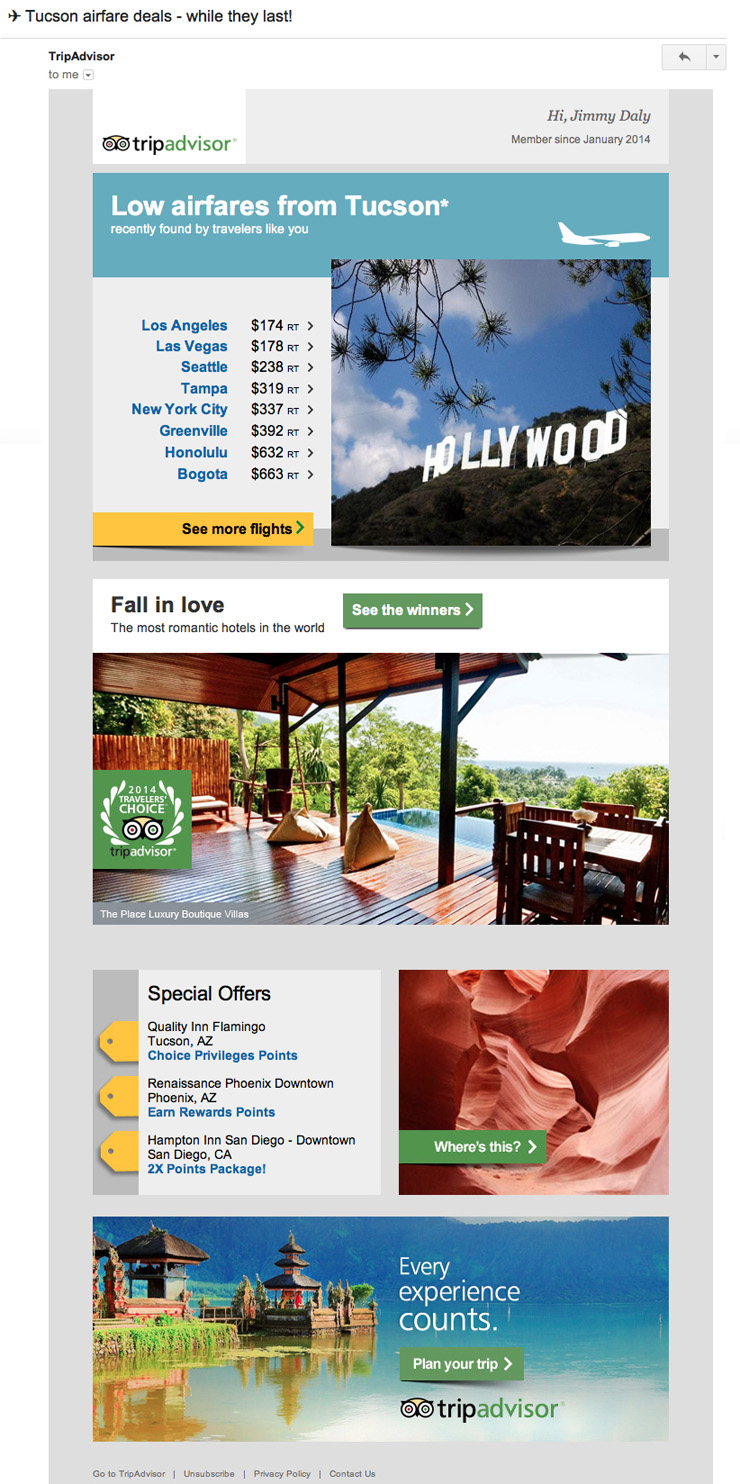
[toc_chapter_title number=”2″ title=”The Peanut Butter Email” color=”green”]
If you’ve never had mice in your house before, you might think that using cheese is a good way attract and trap mice. But once you’ve actually experienced trapping mice, you know that it’s peanut butter, not cheese, that draws them into your traps. A little knowledge goes a long way in solving your problem.
Between the first and second emails, I spend some time on TripAdvisor looking at hotels in Sedona, Ariz., a fairly clear sign that I have intentions to travel. As a direct result of that behavior, TripAdvisor put Sedona front and center in this email.
They know I don’t want cheese, so they’re enticing me with peanut butter.
No matter how large we are, I always want to maintain a startup mentality.
Steve Kaufer, TripAdvisor Founder and CEO
I didn’t give them quite enough data to be sure that I’m heading to Sedona, so they also included links to other cities in the Southwest. They are one step closer to figuring out my plans. This email is another feeler and it could very well generate the data they need to send a strong call to action to actually book a hotel.
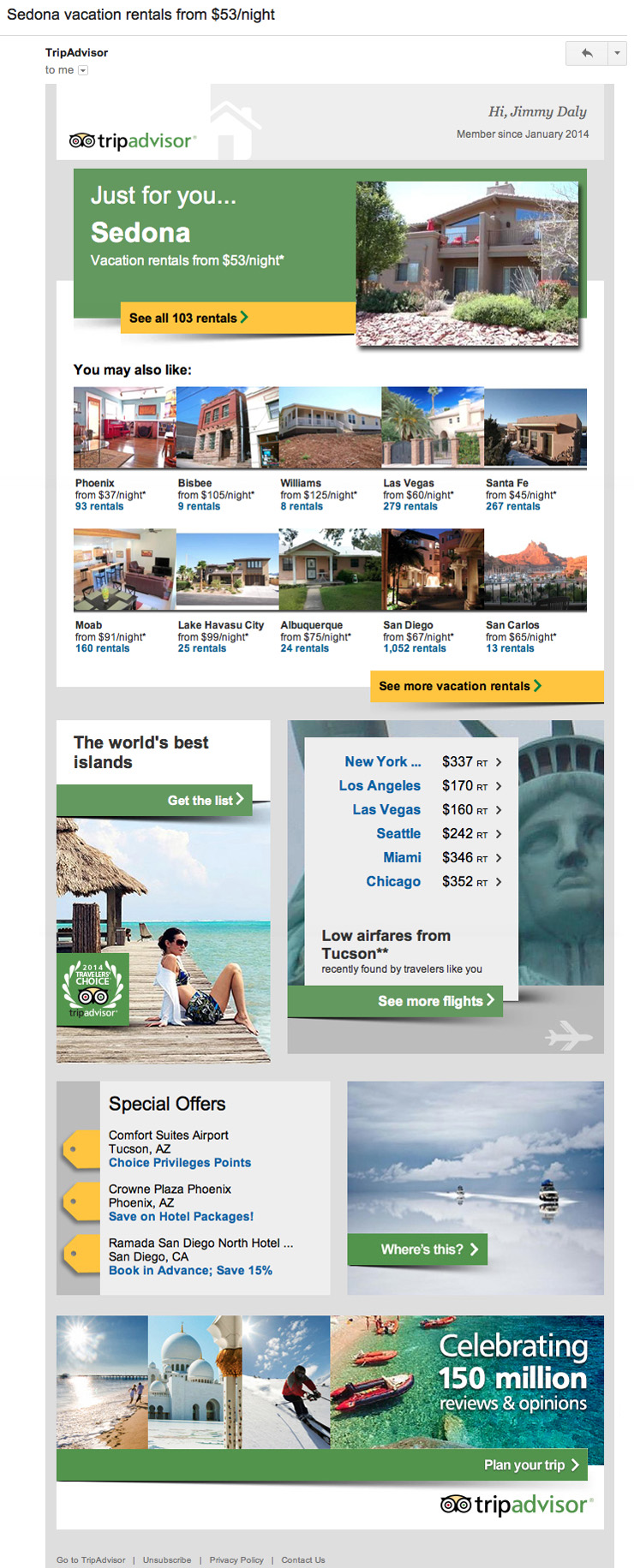
[toc_chapter_title number=”3″ title=”The Eye Candy Email” color=”red”]
This email looks similar to the previous one. That’s because TripAdvisor didn’t get the data they need to send the email they want.
Instead, they’re using their massive reservoir of content to get me moving. They need me on the site to accurately track behavior and intent. So while this email isn’t very personalized, it has something else that’s very important: eye candy.
Travel is inspiring. It makes people feel alive. TripAdvisor’s entire business is built on that emotion (more on that soon). Their content strikes just the right tone and includes just the right eye candy to make people feel like they are wasting their life at a computer. They need to get moving.
They fuel the emotion, then satisfy it.
(Now that is what we call bridging the gap.)
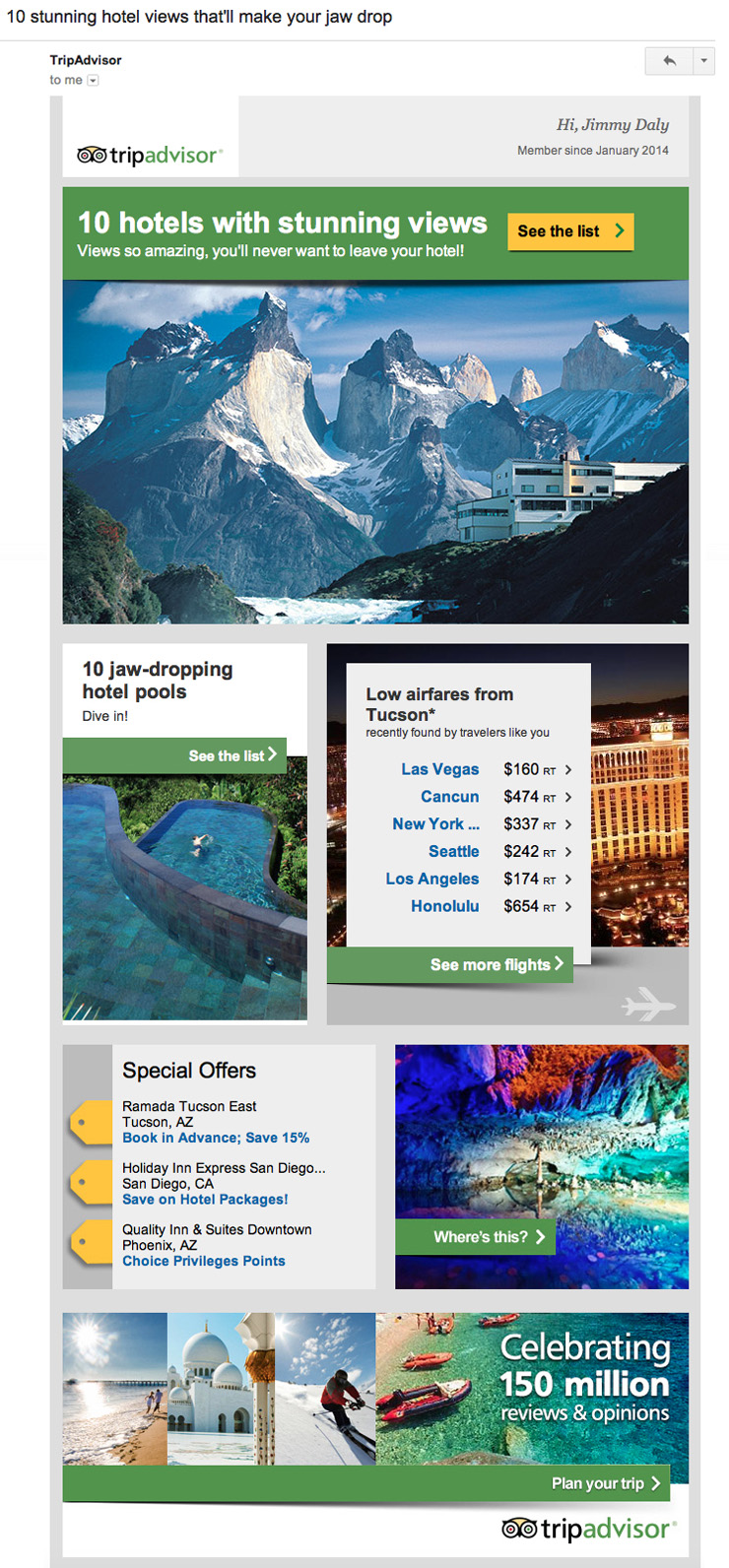
[toc_chapter_title number=”4″ title=”The ‘It’s Your Turn” Email’ color=”gray-blue”]
“Jimmy, you’re just 3 reviews away from your first badge.”
Until now, TripAdvisor has been offering help. Now, they are asking for it.
This marks the beginning of an important transition in TripAdvisor’s email marketing. They have enough data to safely assume that I’ve actually visited some of the places I’ve been researching. And now, instead of feeding me content (as a means to generate behavior and therefore data), they seek engagement. In just one email, TripAdvisor stopped marketing like a publisher and started marketing like a SaaS business.
This process parallels Nir Eyal’s Hooked Method almost perfectly. This stage is called “Investment”.
The last phase of the Hook is where the user is asked to do bit of work. The investment generally comes in the form of asking the user to give some combination of time, data, effort, social capital or money.
TripAdvisor doubles down on the investment phase but framing my action as a social contribution. Rather than asking me help TripAdvisor, they are asking me to help my peers.
This is a lightbulb moment for the user: “I’ve been reaping the rewards of other people’s reviews so I should pay it forward by contributing.”
After a brief value proposition and call to action, they list nearly every place and attraction I’ve viewed since joining the site several months before. This makes it incredibly easy to recognize places I can contribute and actually write reviews.
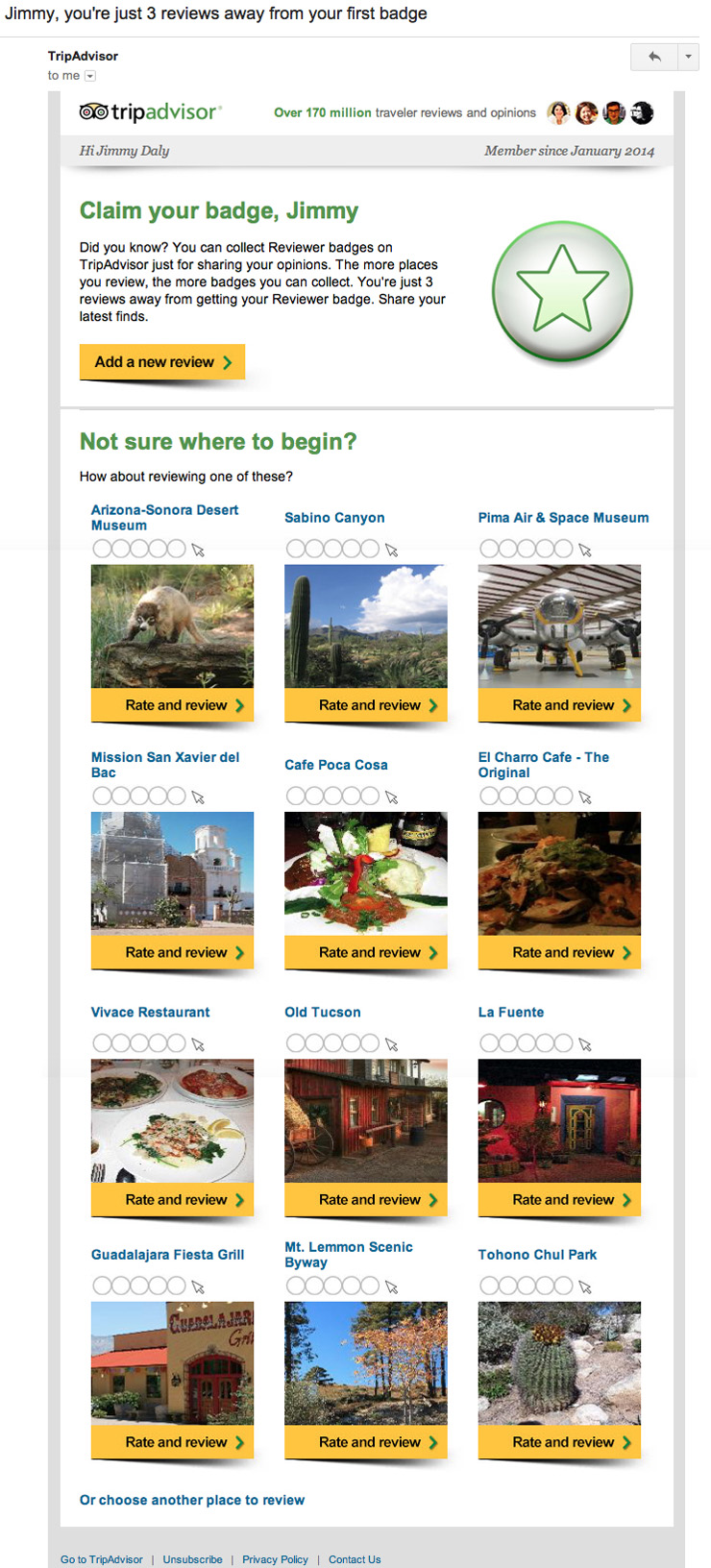
[toc_chapter_title number=”5″ title=”The Abandonment Email” color=”orange”]
This email is very similar to the Airbnb behavioral email that I often refer to as the perfect email.
Here’s why I received this email:
- I browsed hotels in Thailand.
- TripAdvisor asked me when I’d be traveling, so I told them.
- I didn’t book.
As a result of that behavior, TripAdvisor triggered this email personalized with the hotels I looked at as well as additional hotels nearby and in the same price range. They know I’m interested but they also know I haven’t settled on a hotel yet.
It’s like a shopping cart abandonment email one step earlier in the buying cycle.
For every success you see, we’ve had plenty of items that we tested and didn’t work out. You really never know what the next big thing will be.
Steve Kaufer, TripAdvisor Founder and CEO
They use time and geography to personalize a very contextual email. Compare that to a simple newsletter. Are you starting to see the difference between 10 percent growth and 10x growth?
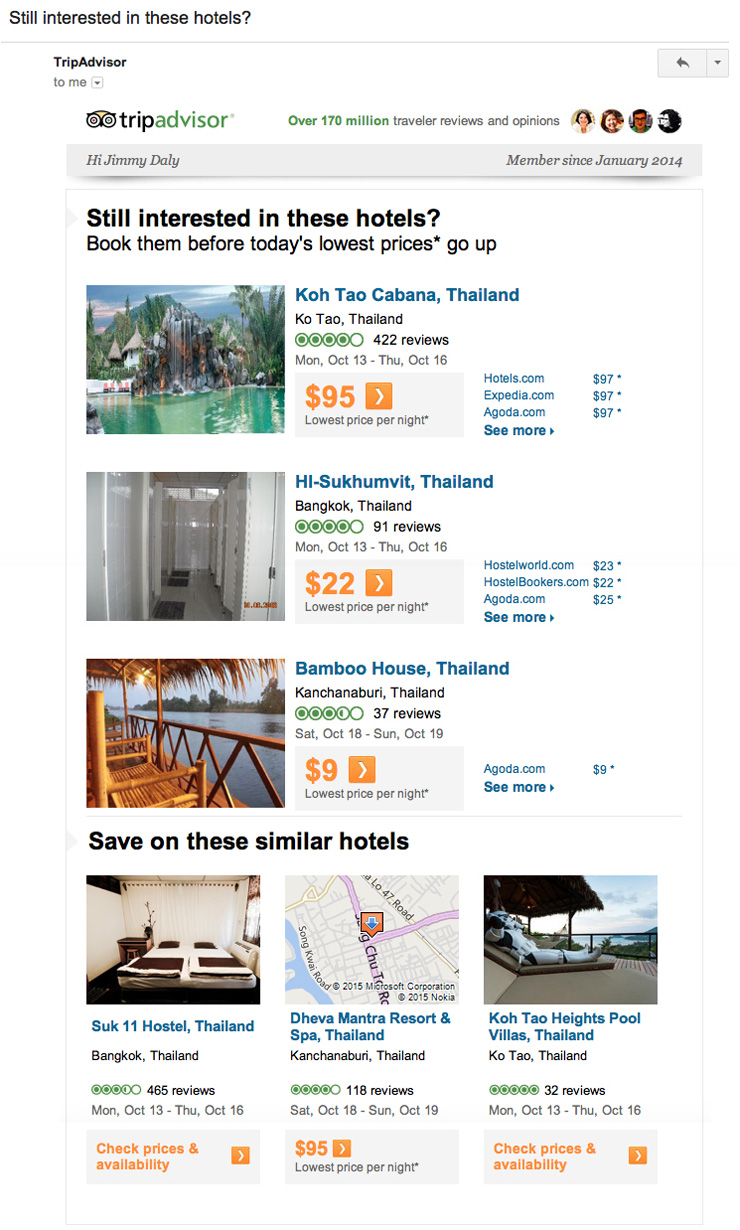
[toc_chapter_title number=”6″ title=”The Price Alert Email” color=”purple”]
This email has a transactional feel to it, which is perfect for the content it delivers.
It’s framed as an alert but it’s loaded with email marketing best practices.
- It uses social proof by showing the number of reviews this hotel has received.
- It’s personalized based on time and location.
- It feels urgent even though there’s no expiration date on this deal.
- It asks if I want more information.
Everything about this email is designed to earn trust. Can you say that about your emails?
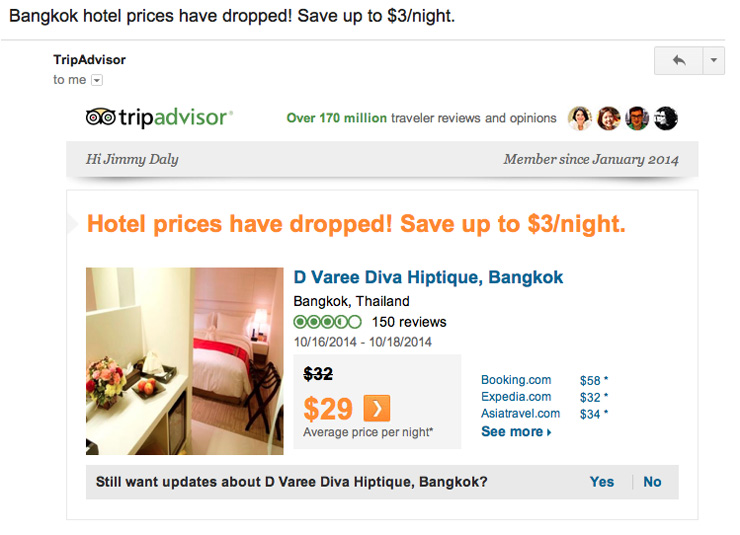
[toc_chapter_title number=”7″ title=”The Direct Response Email” color=”blue”]
TripAdvisor has already established the notion that writing reviews gives back to the community. They send emails exactly like this one to active users on a regular basis.
These emails work because they are so simple and direct. Look at the copy:
You researched several places on TripAdvisor recently. Did you end up going? If so, don’t forget to add your reviews while your trip is fresh in your mind.
They don’t assume anything, they simply remind users to get in the habit of leaving reviews.
The other interesting thing about this email is the subject line: “Did you forget something?”
TripAdvisor ever-so-gently implies that users have an obligation to write reviews since they have benefitted from other people’s reviews.
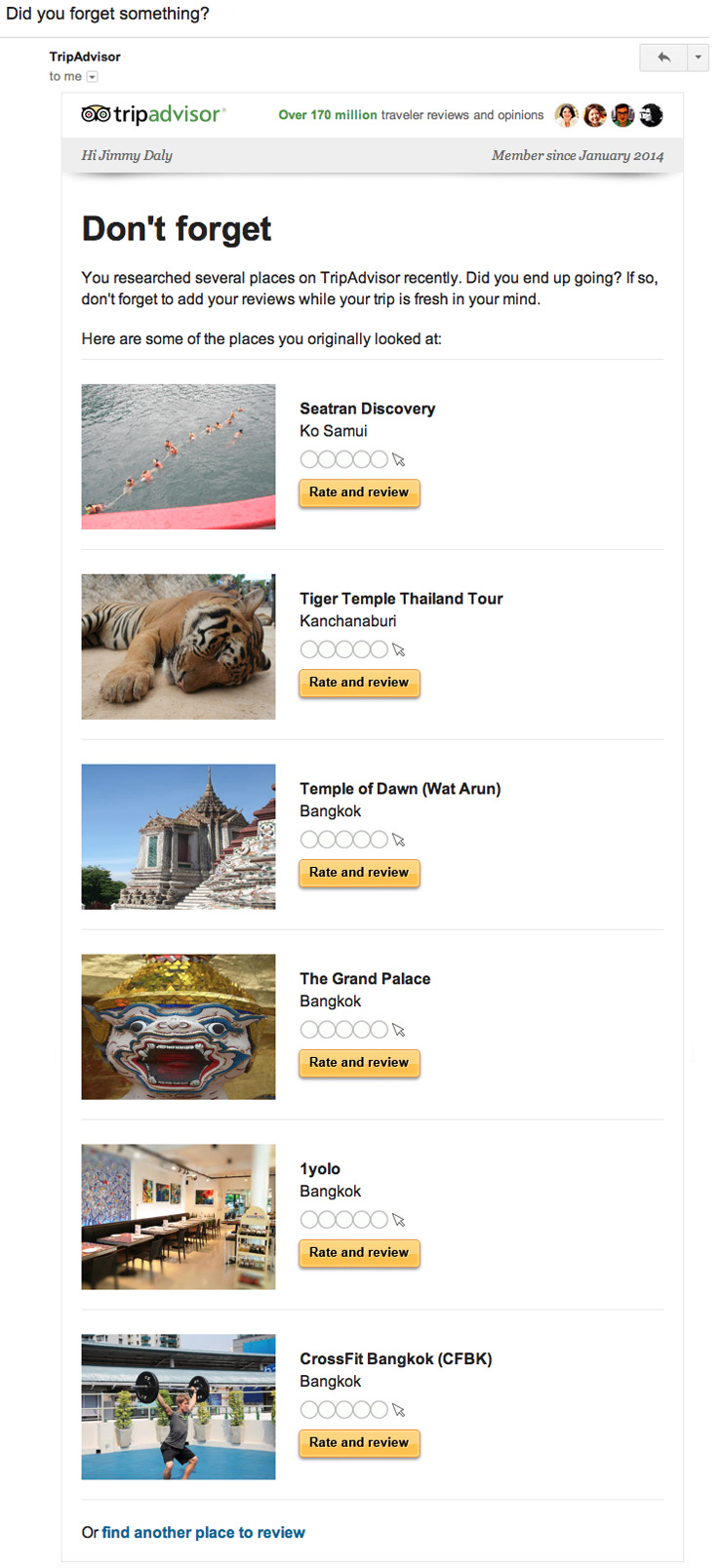
[toc_chapter_title number=”8″ title=”The Social Proof Email” color=”green”]
TripAdvisor takes social proof to a new level. Their Facebook integration means that I can see where my friends have traveled as well as their reviews, all in the name of engagement.
They actually use my Facebook friend’s name in the subject line of this email – talk about personalization!
Think about the psychology at work here. TripAdvisor is using my friends’ contribution as a way to encourage me to contribute as well. The theme in these emails looks like this:
We help you > We help you > We help you > Okay, now you help us.
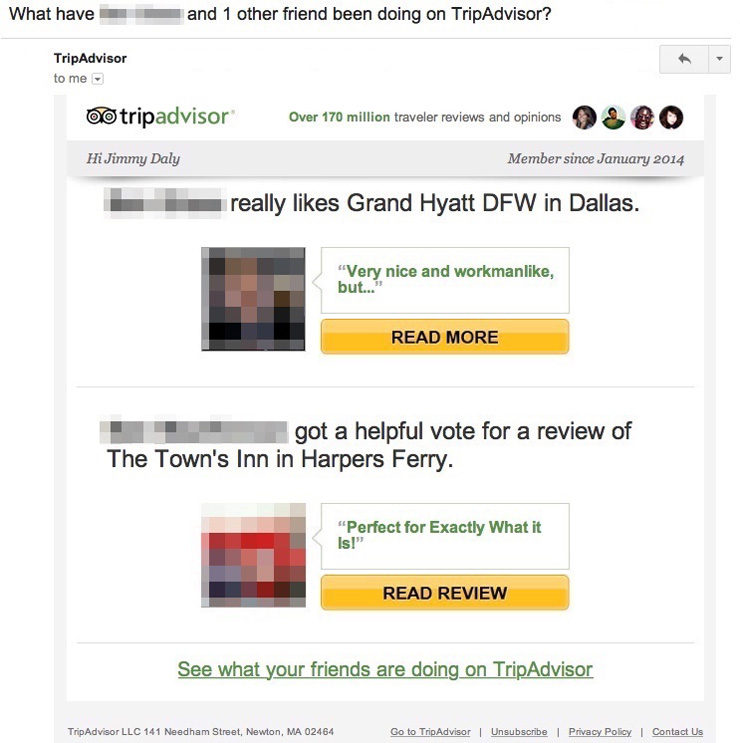
[toc_chapter_title number=”9″ title=”The ‘Same Picture, Different Frame’ Email” color=”red”]
Wait, haven’t we already seen this email?
Well, sort of.
One of the brilliant tactics TripAdvisor employs is to approach the same topic from different angles. In email #5, they sent a list of hotels that I’d previously looked at. The subject line was “Are you still interested in these hotels?”
This is email is nearly identical with one important change – it’s framed like a newsletter. Look at the first line of copy: “This week’s traveler advice for you.”
The emails have the same goal, same content and same layout but take a very different approach. It’s a clever way for TripAdvisor to seek engagement without loading up the inbox with duplicate emails.
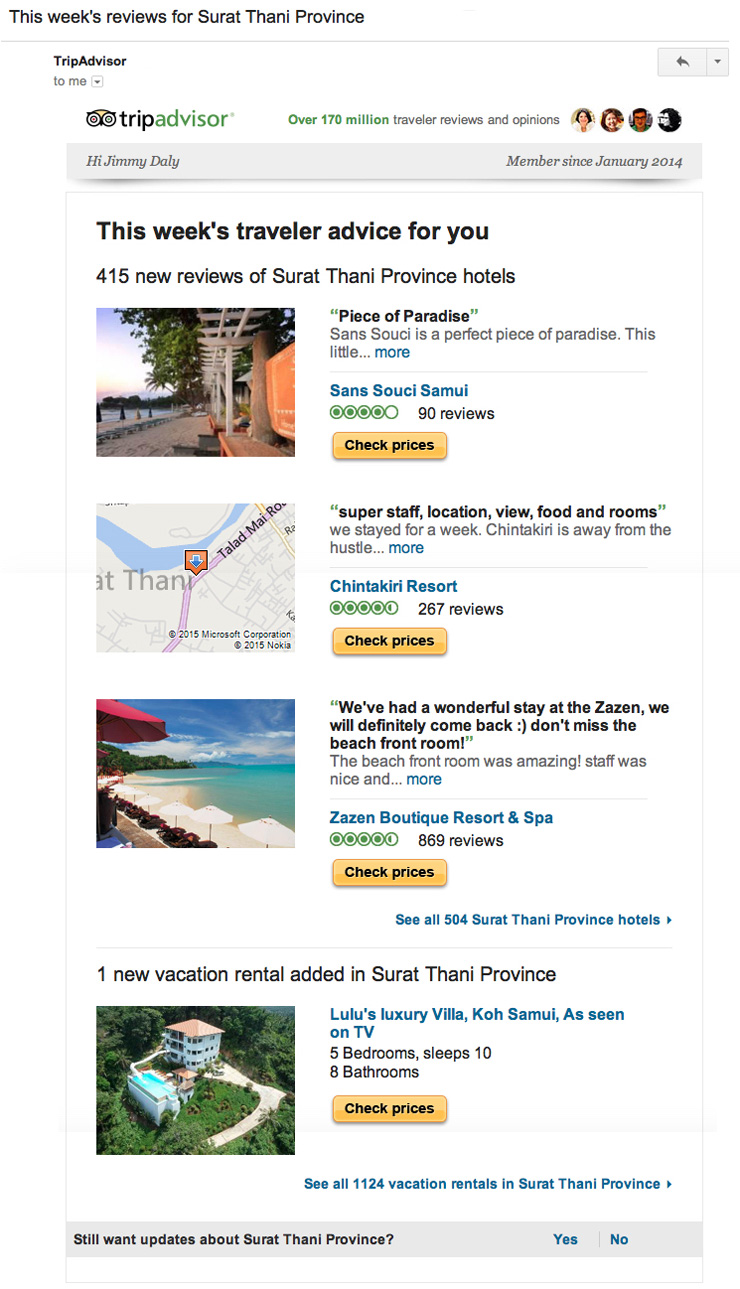
[toc_chapter_title number=”10″ title=”The Milestone Email” color=”gray-blue”]
This is a perfect example of a milestone email.
Milestone emails reward good behavior and build on momentum. In this email, TripAdvisor makes a big deal about my first review. Take note of the copy, which emphasizes that my review is a contribution to the community.
It’s great to see new reviewers join our travel community and help fellow travelers.
They don’t waste any time asking me for another review. Momentum is key to engagement. TripAdvisor strikes while the iron is hot by providing a list of other places I’ve researched and calls to action for each.

[toc_chapter_title number=”11″ title=”The Pseudo-Transactional Email” color=”orange”]
In our massive lifecycle email marketing guide, there’s a section on Fake Transactional Emails.
There’s nothing dishonest about these emails. The sender is smart enough to include so much context that the emails feels transactional even if it’s clearly a lifecycle email.
That’s exactly what TripAdvisor has done here. The email is expected, so it’s nearly guaranteed to be opened. And it makes the user feel good, so it’s nearly guaranteed to be clicked. TripAdvisor has created a loop where customers enjoy their emails because of the context, not just the message.
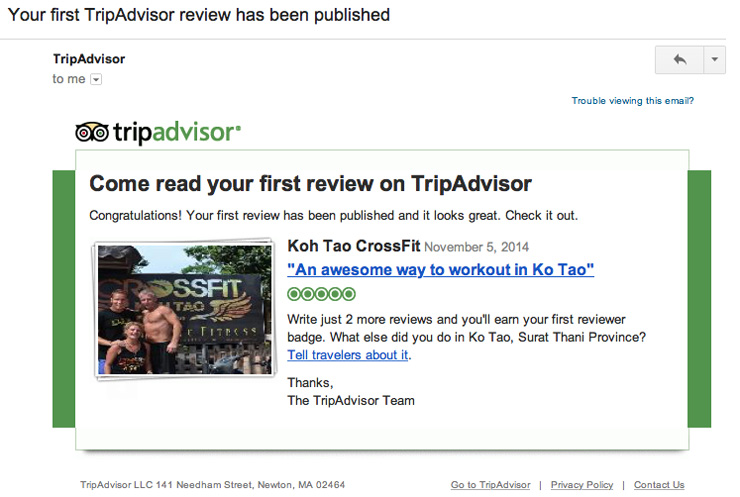
[toc_chapter_title number=”12″ title=”The Spike Email” color=”purple”]
Take a look at the date on this email. It was sent on the same day as the one above.
Why not just combine them into one email to reduce noise in the inbox? Two reasons:
- One call to action is enough. The first email has no real call to action – it’s intended to invoke emotion from the recipient – while the second has a strong call to action. You can’t include both and reasonably expect people to convert. .
- TripAdvisor doesn’t have to play by the rules. Any email marketing expert will tell you not to email people twice in a day. Unless, of course, you’ve completely thrown out the rule book. TripAdvisor uses the first email as a foundation for the second one. It tees up the emotion and good feelings, then swoops in to turn those good vibes into engagement. The first email was an assist, this is the spike
This isn’t your grandma’s marketing – it’s a whole new way to think about email.

[toc_chapter_title number=”13″ title=”The Harley Davidson Email” color=”blue”]
TripAdvisor is giving like-minded people a place to come for inspiration and identity. Here’s Seth Godin on creating tribes:
There were Harley-type renegades before there was Harley Davidson. There were digital nomads before there was Apple. There were pop music fans before there were the Beatles and Rastafarians before Marley.
Our job is to find the disconnected and connect them, to find people eager to pursue a goal and give them the structure to go achieve that goal. But just about always, we start with an already existing worldview, a point of view, a hunger that’s waiting to be satisfied.
Sending magnets to people who leave reviews is one way to create a tribe. People with TripAdvisor magnets on their car aren’t active TripAdvisor users, they are thoughtful, inspired travelers.

[toc_chapter_title number=”14″ title=”The Warm and Fuzzy Email” color=”green”]
One thing you’ll notice in all of TripAdvisor’s marketing is that they reward good behavior. Every engagement is an event worthy of a thank you note.
This email is one in a series of many that reinforces the notion of giving. The more I give, the more I’m rewarded. It’s a powerful cycle, and it’s turned millions of would-be lurkers into contributors.
Get shit done and get it done faster. There’s no point in going slow.
Steve Kaufer, TripAdvisor Founder and CEO
Without context, this email seems nearly worthless. The call to action isn’t especially strong and the design isn’t especially beautiful. But, remember, it’s one of many. It’s a small win that can’t be overlooked.

[toc_chapter_title number=”15″ title=”The Double Duty Email” color=”red”]
From this point on, TripAdvisor starts including metrics in their emails to me. Data is on working overtime – they’re using it as a trigger but also as content. The email stays true to their theme – making users feel really good about their association with TripAdvisor – but takes a quantitative approach.
The goal of this email is to prove to me that my contributions are valuable. What better way than hard data to make that case?
Take note of just how personalized this email is. The logic to send this message looks something like this:
Trigger [Top 10% email] when [user] writes more reviews than 90% of [all users] in [Tucson] within [7 days].
That’s pretty different than queuing up one newsletter for an entire list. It’s a serious investment in data and triggers. But now that the investment is made, brilliant emails like this are automated. They are triggered at just the right time for every user.
You want to 10x your business? Start thinking this big.
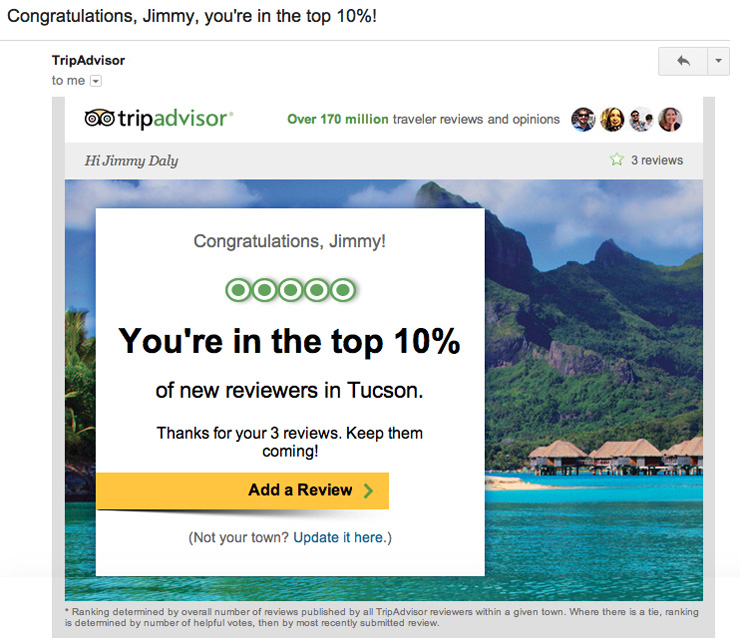
[toc_chapter_title number=”16″ title=”The Analytics Email” color=”blue-gray”]
It’s would easy to explain to users why writing more reviews is helpful to other travelers but TripAdvisor lets the data do the talking.
In only 7 days, your reviews have had 107 readers
Travelers really love your latest reviews.
And you’re just 3 reviews away from your Senior Reviewer badge. Keep going!
The copy is upbeat, positive and encouraging. When you get this email, it actually feels like you’re being called to duty. It makes you feel like your knowledge is valuable and others could really benefit from it.
That’s true, of course, and TripAdvisor does an excellent job communicating that message in as few words as possible.
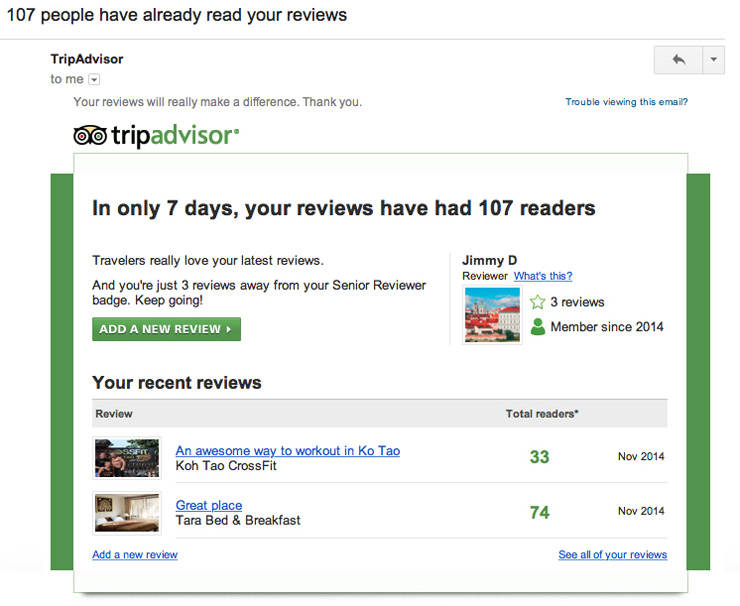
[toc_chapter_title number=”17″ title=”The Small Win Email” color=”orange”]
Tip #6 in our email marketing best practices guide is “Make conversion a habit.” The idea is that even small conversions grow your relationship with each and every user.
David Sherry from Death to the Stock Photo includes a download in every email. Brian Dean from Backlinko asks people to reply to this emails. TripAdvisor asks people to add reviews.
If people are used to engaging with your emails and getting value as a result, it will be much easier to ask for bigger commitments down the road.

[toc_chapter_title number=”18″ title=”The Notification Email” color=”purple”]
Here’s another example of a Small Win email. These emails are designed to:
- Introduce people to features or products
- Build trusting relationships with content
- Start a real, genuine conversation
- Build momentum towards a bigger goal
In this case, TripAdvisor uses a notification email to remind me about Facebook integration. In fact, every time one of my Facebook friends joins TripAdvisor, I get an email about it.
Why are you emailing me? If you can’t tell me in six words what you need me to do, it’s unlikely I’ll be able to guess.
You might say this is just an excuse to send another email but it’s actually a valuable opportunity to get users exploring new areas of the site. Now that I can see where my friends have traveled, I will likely discover new places I want to visit as well, further deepening my reliance on TripAdvisor.
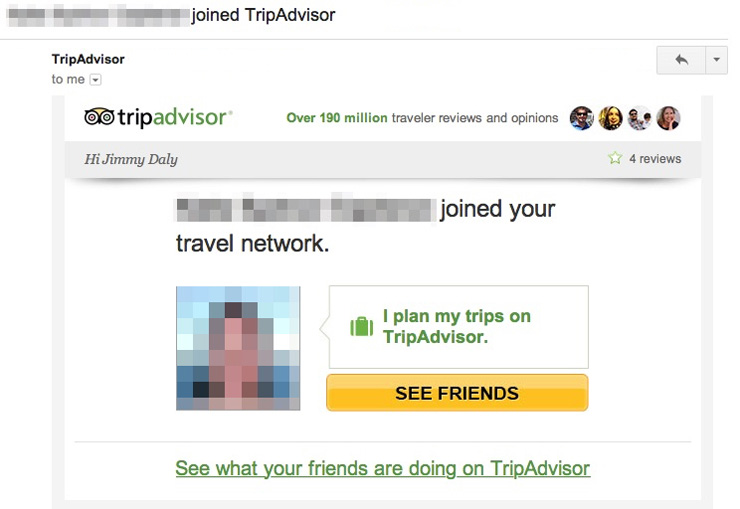
[toc_chapter_title number=”19″ title=”The Holiday Email” color=”blue”]
Tying your marketing into current events and holidays is the oldest trick in the book. But that doesn’t mean it can’t work.
TripAdvisor found a hook – lots of people visit bars and restaurants on New Year’s Eve – that opens the door to ask for a review. It’s logical, it’s familiar and it’s timely.
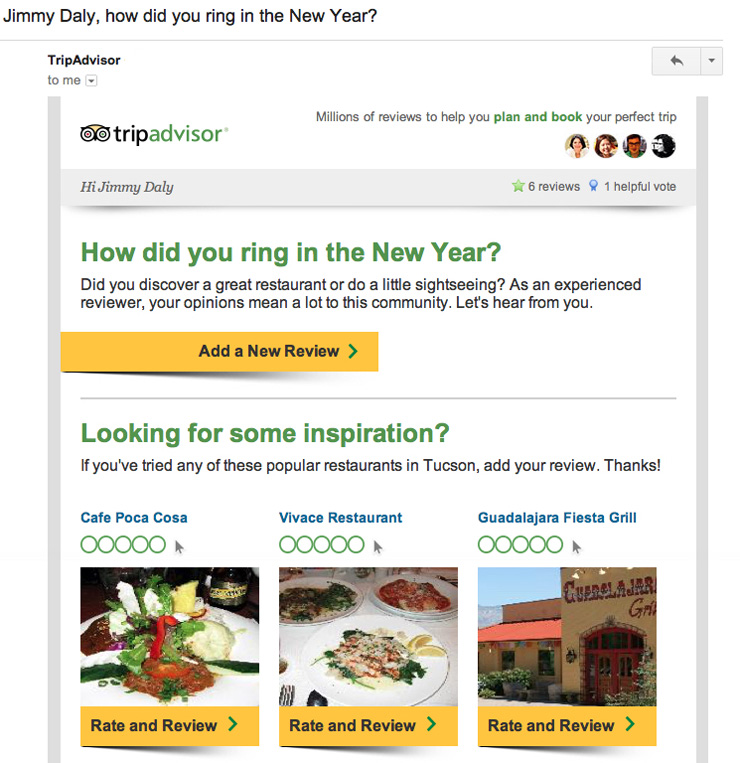
[toc_chapter_title number=”20″ title=”The Monthly Report Email” color=”green”]
This is one of the smartest emails I’ve ever seen.
This email – the monthly report – has it all. It’s behavioral, it’s completely personalized, it’s data-driven, it’s gamified and it has a strong call to action.
It’s framed as a report but it’s designed specifically to be an engagement tool. No one is more clever than TripAdvisor when it comes to attacking one call to action from many angles.
Even though it’s loaded with every best practice in the book, this email is actually really simple. Every SaaS product has data on their users. TripAdvisor has simply collected a few key data points and added context. And the result is something really special.
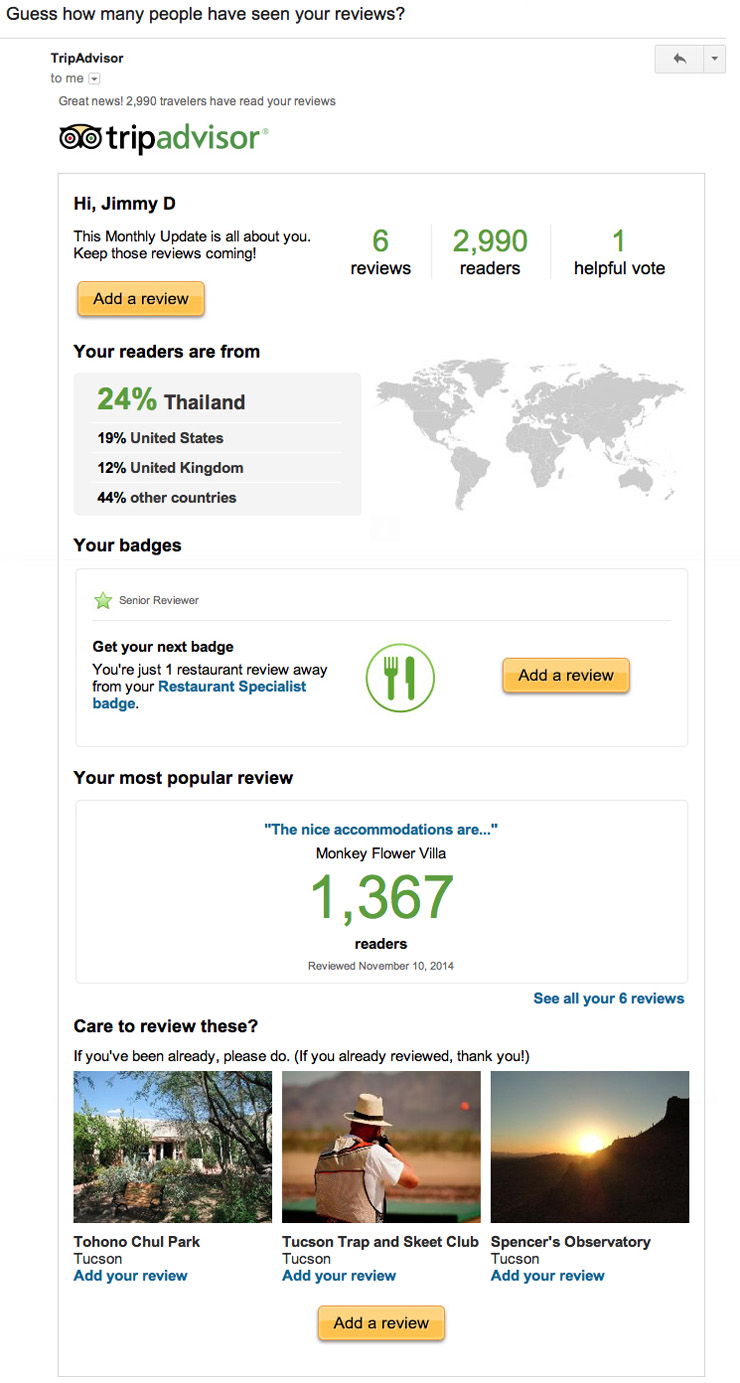
How do you think you can apply TripAdvisor’s strategy to your own CRM? Let us know in the comments.

